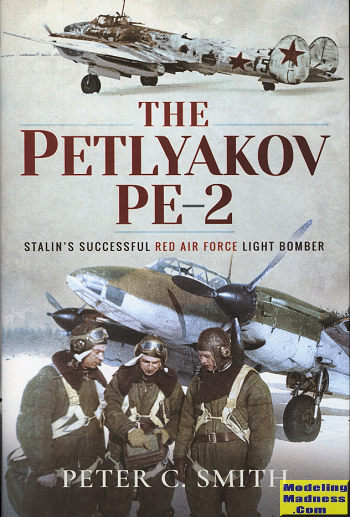 Probably one of
the best dive bombers that the world has rarely heard of, the Pe-2 was an
aircraft that had a somewhat convoluted development and an equally convoluted
operational career. It was designed by one of many of Stalin's designers in
prison. The purpose was to build a modern and fast bomber than was also an
accurate dive bomber.
Probably one of
the best dive bombers that the world has rarely heard of, the Pe-2 was an
aircraft that had a somewhat convoluted development and an equally convoluted
operational career. It was designed by one of many of Stalin's designers in
prison. The purpose was to build a modern and fast bomber than was also an
accurate dive bomber.
Not surprisingly, when a leader decides to imprison his
most talented people, it took a while for the design to leave the drawing board
and into testing. Several glitches were discovered, some of which were fixed and
others not. For instance it was rather unstable in yaw. It's landing gear was
such that the plane easily 'bounced' when landing (this was never really fixed).
It also had major issues with engine cooling and the engines themselves were
fairly unreliable and did not produce the needed power to fully meet
requirements.
Still, it was put into production just prior to the
start of the war so some actually made it into service where the accident rate
was high. The plane took a long time to get off the ground and had to be 'flown'
in for landings rather than just coast in like other planes. With the Germans
closing in on its plant near Moscow, everything was uprooted and moved to the
Urals, further delaying production.
Testing had shown that the aircraft was fast, fairly
well armed and was a very accurate dive bomber. However, it took a pilot of some
skill to properly fly the plane and skilled pilots were not what most bomber
units got. As a result, most missions were level bombing and ground attack.
However, its speed was perfect for a reconnaissance unit and the aircraft served
well in that mission. It was even developed into a straight fighter version, the
Pe-3. Like the Bf-110, it was not good against single engine fighters, but it
was fairly heavily armed and again, was useful in the ground attack mission.
When you combine a plane that needed a skilled pilot,
unreliable engines and generally shoddy construction, it is not surprising that
many airplanes were lost. However, Stalin's look on the whole thing was that
planes and crews were highly expendable and when lost were fairly easily
replaced. Like the rest of Soviet industry during it war, it eventually ramped
up to speed and produced sufficient to meet the needs, even if it was fairly
poorly constructed and not used to the best of its design abilities.
The author has obviously done a lot of research into
this aircraft. As usual with things Russian, not all the information you'd need
was available for various reasons. Yet we are provided with an excellent book
that provides the design, development and use of the subject aircraft. All of
the myriad prototypes and special use aircraft are covered and there is a goodly
section of its use throughout the war. This section includes a fair number of
biographies of luminaries as well as the pilot stories that we have come to
enjoy in books such as this. While some color profiles would have been
appreciated, we are given a goodly number of period photos. There is a chapter
on color and markings that brings to light information previously unknown on the
aircraft. A section is also provided on the few surviving airframes and there is
a part on the Pe-2s use in foreign service post war. Appendices includ
Pe-2/3 units, unit commanders, some pilot biographies, and a list of aces.
In all, it is the best book yet written on the type and
is well worth picking up.
July 2020
Review book courtesy of
Casemate Publishing, where you can order your copy of this and many other superb books
and DVDs. You can get this particular book
at this link.
If you would like your product reviewed fairly and quickly, please
contact
the editor or see other details in the
Note to
Contributors.
 Probably one of
the best dive bombers that the world has rarely heard of, the Pe-2 was an
aircraft that had a somewhat convoluted development and an equally convoluted
operational career. It was designed by one of many of Stalin's designers in
prison. The purpose was to build a modern and fast bomber than was also an
accurate dive bomber.
Probably one of
the best dive bombers that the world has rarely heard of, the Pe-2 was an
aircraft that had a somewhat convoluted development and an equally convoluted
operational career. It was designed by one of many of Stalin's designers in
prison. The purpose was to build a modern and fast bomber than was also an
accurate dive bomber.